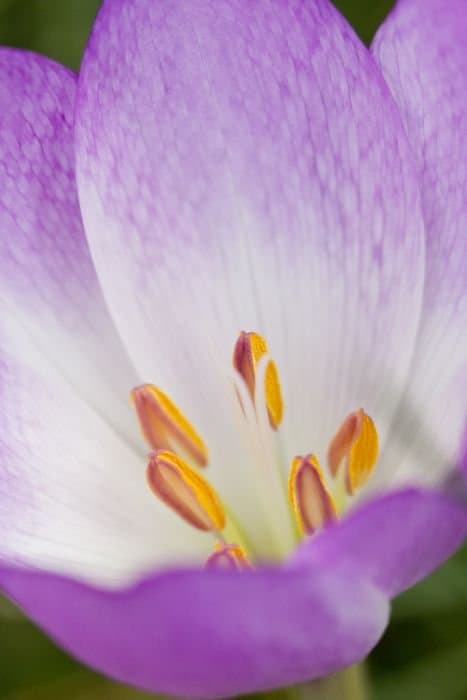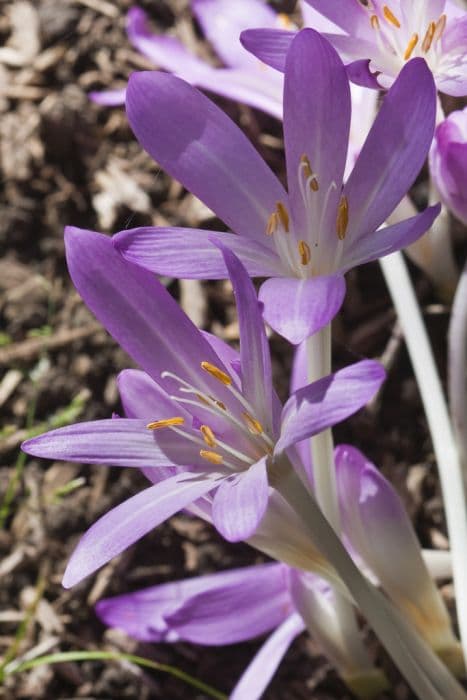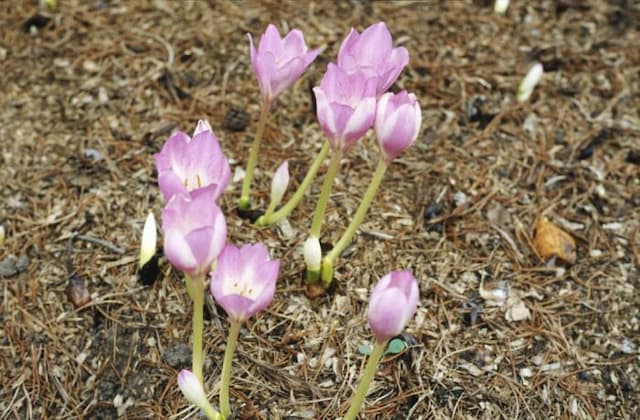Flame Lily Gloriosa superba
ABOUT
The Glory Lily is a striking and unique plant notable for its showy flowers and climbing habit. This plant has thin, tendril-like vines that emerge from a tuberous root and use other plants for support as they grow, resembling a vine. The leaves are lance-shaped and glossy green with a distinctive feature: they end in tendril-like spirals that help it to grip and climb. What really sets the Glory Lily apart are its vibrant flowers. These blooms are large, with six petals that dramatically recurve backwards, resembling a flamenco dancer's twirling skirt. The color of the petals is a fiery display of yellow, red, and orange hues, often with a gradient effect that starts with a lighter shade at the base and deepens to a dark, rich color at the tips. At the center of the flower, the reproductive parts form a prominent contrast, often appearing in a deeper or complimentary shade, adding further drama to the flower's appearance. The blooming period of the Glory Lily brings a spectacular splash of color to its environment, which, paired with its unusual flower shape, makes it a memorable sight. The Glory Lily's climbing nature and the elegance of its flowers make it a fascinating and exotic addition to any garden or collection, where it lends vertical interest and a touch of the tropics.
About this plant
 Names
NamesFamily
Colchicaceae.
Synonyms
Flame Lily, Gloriosa Lily, Fire Lily, Climbing Lily, Creeping Lily, Glory Lily, Superb Lily, Gloriosa.
Common names
Gloriosa simplex, Methonica superba, Littonia superba, Methonica doniana, Gloriosa doniana, Gloriosa angustifolia, Gloriosa virescens, Gloriosa rothschildiana, Gloriosa abyssinica, Gloriosa carsonii, Gloriosa minor, Gloriosa lutea, Gloriosa rockii, Gloriosa verschuurii.
 Characteristics
CharacteristicsLife cycle
Perennials
Foliage type
Deciduous
Color of leaves
Green
Flower color
Red
Height
3-8 feet (0.9-2.4 meters)
Spread
1-3 feet (0.3-0.9 meters)
Plant type
Climber
Hardiness zones
9
Native area
Africa Asia
Benefits
 General Benefits
General Benefits- Ornamental Value: Gloriosa superba, commonly known as Flame Lily, adds aesthetic appeal to gardens with its unique and vibrant red and yellow flowers.
- Climbing Ability: As a climbing plant, it can provide vertical garden interest, creating a vivid backdrop or covering unsightly structures.
- Easy Propagation: Flame Lily can be easily propagated from tubers or seeds, allowing gardeners to share and spread the plant.
- Drought Tolerance: Once established, this plant is relatively tolerant of dry conditions, reducing the need for frequent watering.
- Heat Tolerance: It is well-suited for warmer climates and can thrive in hot temperatures, making it a good choice for tropical and subtropical gardens.
- Soil Adaptability: Flame Lily is adaptable to a variety of soil types, though it prefers well-draining soil, making it versatile in different garden settings.
- Pollinator Attraction: The vibrant flowers attract pollinators like bees and butterflies, contributing to the health of the local ecosystem.
 Medical Properties
Medical Properties- Antiparasitic: Gloriosa superba has been used to treat intestinal worms and other parasitic infections.
- Anti-inflammatory: It contains compounds that may reduce inflammation and has been used in traditional medicine for this purpose.
- Analgesic: The plant's extracts have been used for their pain-relieving properties.
- Emmenagogue: The plant has been used to stimulate menstrual flow and address issues related to menstruation.
- Abortifacient: Gloriosa superba has been employed as an abortifacient in traditional practices, although this use is highly unsafe and not recommended.
- Arthritis treatment: Some traditional medicine systems use it to treat arthritis and related conditions.
- Skin conditions: It has been used to treat skin issues such as itching, eczema, and bruises.
- Leprosy: There have been traditional uses aimed at treating leprosy with Gloriosa superba.
- Gout: The plant has been employed for relieving symptoms associated with gout in some traditional medicine practices.
 Air-purifying Qualities
Air-purifying QualitiesThis plant is not specifically known for air purifying qualities.
 Other Uses
Other Uses- Gloriosa superba, commonly known as the flame lily, is sometimes used in traditional ceremonies and rituals in some cultures due to its striking appearance.
- The tubers have been used as a natural soap substitute because they contain compounds that can produce a lather when mixed with water.
- In parts of Africa, the flame lily is used as a natural fencing material, as its climbing nature can create barriers that deter animals and humans.
- It's also incorporated into traditional dance costumes in some regions for its vibrant colors and unique floral structure.
- The plant has been utilized as a natural insect repellent, with some communities believing that the sap or crushed leaves can deter insect pests.
- Flame lily has been used in basket weaving industry; the vines are strong enough to be woven into intricate patterns and designs.
- The plant is sometimes used as a component in animal feed, especially for livestock, as a means to provide variety in their diet.
- In ornamental horticulture, flame lily is used to create living architectural elements, such as arches or columns, due to its climbing habit.
- The striking appearance of Gloriosa superba is used in the art world as a subject for paintings, drawings, and textile designs.
- Its dried seed pods are incorporated into decorative crafts and jewelry, adding a unique and natural element to such items.
Interesting Facts
 Feng Shui
Feng ShuiThe Flame Lily is not used in Feng Shui practice.
 Zodiac Sign Compitability
Zodiac Sign CompitabilityThe Flame Lily is not used in astrology practice.
 Plant Symbolism
Plant Symbolism- Glory and Honor: The Gloriosa superba, commonly known as Flame Lily, is often seen as a symbol of glory and honor due to its impressive and vibrant fire-like petals that stand out in a garden.
- Beauty and Passion: Its striking appearance and unique shape often associate it with beauty and a passionate nature.
- Pride: Similar to the symbolism of glory, the Flame Lily can also represent pride, reflecting its bold and confident stance.
- Wealth: In some cultures, the rare and eye-catching aspects of the Flame Lily symbolize wealth and prosperity.
- Creativity: Its unusual and intricate form may symbolize an artistic or creative spirit, embodying the uniqueness and inventiveness of the individual.
- Caution and Danger: Due to its toxic properties, the Flame Lily also serves as a symbol of caution and danger, alerting to the hidden perils that might be overlooked by its beauty.
 Water
WaterThe Flame Lily should be watered when the top inch of soil feels dry to the touch, which typically means once every 1 to 2 weeks, depending on the humidity and temperature conditions. This tropical plant prefers consistent moisture during its growing season, so aim to provide around half a gallon of water every two weeks, ensuring you do so evenly around the plant without waterlogging the soil. When the plant is dormant, usually in the cooler months, reduce watering significantly to prevent root rot.
 Light
LightFlame Lilies thrive in bright, indirect sunlight. The ideal spot for this plant would be a location that receives morning sunlight with dappled shade in the afternoon. Avoid direct, harsh sunlight as it may scorch the leaves, but make sure it gets enough light to support its vigorous growth and flowering.
 Temperature
TemperatureFlame Lilies prefer warm conditions and do well in temperatures ranging from 60 to 90 degrees Fahrenheit. The plant can survive a minimum temperature of around 50 degrees Fahrenheit but should be protected from frost, as cold temperatures can damage or kill the plant. Ideally, keep this plant in an environment where temperatures are consistently above 60 degrees Fahrenheit.
 Pruning
PruningPruning the Flame Lily is mostly done to remove dead or yellowing leaves and spent flowers to encourage new growth and maintain the plant's appearance. It is best to prune after the flowering season has ended. Prune lightly, ensuring that you do not remove more than one-third of the plant at any pruning session to keep it healthy and thriving.
 Cleaning
CleaningAs needed
 Soil
SoilThe Flame Lily thrives in well-drained, loamy soil with high organic content. A mix of two parts loam, one part sand, and one part compost or peat moss is ideal. The soil pH should range between 6.0 to 6.5 for optimal growth.
 Repotting
RepottingFlame Lily should be repotted every 2-3 years, or when you notice that the tubers have filled the pot and appear crowded. Best done after the dormant period, as new growth begins.
 Humidity & Misting
Humidity & MistingFlame Lily prefers high humidity levels, typically between 50-70%. It's important to maintain consistent humidity without making the atmosphere overly wet, as this can encourage fungal diseases.
 Suitable locations
Suitable locationsIndoor
Place in bright, indirect light and ensure high humidity for Flame Lily.
Outdoor
Plant in dappled shade with well-draining soil for Flame Lily.
Hardiness zone
9-11 USDA
 Life cycle
Life cycleGloriosa superba, commonly known as the flame lily, begins its life cycle as a tuber, which germinates and sprouts into a vine with the aid of the warmth and moisture found in its tropical and subtropical climate. It grows rapidly, using other plants for support, and its leaves grasp onto objects with tendrils at the leaf tips. After several weeks to months, it reaches the flowering stage, where vibrant red and yellow flowers bloom, usually during the warm and wet season. These flowers are pollinated by insects and some birds, leading to the development of elongated capsules filled with seeds. The seed capsules eventually dry and release seeds which can be dispersed by wind or animals. When the dry season approaches, the above ground parts of the plant wither, and the plant remains dormant underground until the next favorable growth season.
 Propogation
PropogationPropogation time
Spring-Early Summer
The most popular method of propagating the Flame Lily (Gloriosa superba) is through its tubers. The best time to propagate the plant by tubers is in the spring after the danger of frost has passed. To do this, carefully dig up the tubers, which resemble small, elongated potatoes, and gently separate them, ensuring that each segment has at least one growth point. These tuber sections can then be planted about 2 to 4 inches deep (5 to 10 centimeters) in well-draining soil with the growth points facing upwards. Water the newly planted tubers thoroughly and wait for the shoots to emerge, after which regular care can help them grow into vibrant Flame Lilies.









